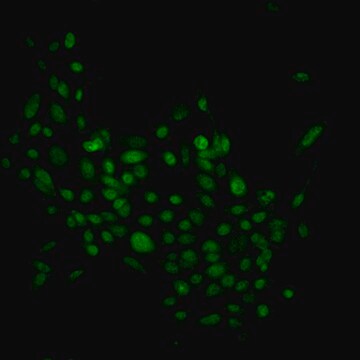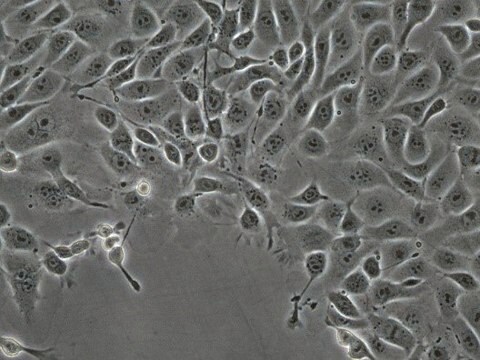Descrição geral
SCC626, the mouse E6/E7/hRas (mEER) cell line, was established by the retroviral transduction of the HPV E6 gene, the HPV E7 gene, and the human hRas G12V gene into primary mouse oropharyngeal epithelial cells. It had been established that HPV E6 and E7 promote head and neck cancer.
Aplicação
mEER cells are verified to be of mouse origin and negative for human, rat, Chinese hamster, Golden Syrian hamster, and non-human primate interspecies contamination, as assessed by a Contamination Clear panel by Charles River Animal Diagnostic ServicesCells tested negative for infectious diseases against a Mouse Essential CLEAR panel by Charles River Animal Diagnostic Services.Cells tested negative for mycoplasma.
Características e benefícios
The SCC626 mEER Mouse E6/E7/hRas Oropharynx Epithelial Cell Line is useful in the study of head and neck squamous cell carcinoma in an immunocompetent, syngeneic animal model.
Descrição-alvo
Head and neck cancers represent the sixth most common type of cancer. Among them, incidence of oropharyngeal squamous cell carcinoma (OPSCC) are on the rise, and a majority are driven by the human papilloma virus (HPV). While successful management methods exist, the local recurrence and the nodal metastasis result in mortality in some cases. Historically, insights into HPV-induced transformation have been obtained in the context of cervical cancer and anogenital warts models, and, while much of it is relevant to OPSCC, it is beneficial to have systems in which the effects of HPV infection can be studied in a context specific to OPSCC.SOURCE SCC626 was established by the retroviral transduction of the HPV16 E6 gene, HPV16 E7 gene, and the human hRas gene into the primary oropharyngeal epithelial cells isolated from a male C57BL/6 mouse. mEER cells are the parent to mEERL cells and the MLMs were derived from lung metastases from a mouse with a mEERL tumor that got treatment (cisplatin/radiation) and had a recurrence. REFERENCES1.Kademani D. 2007. Oral cancer. Mayo Clin Proc. 82(7): 878-87. 2.Rogers SN, Brown JS, Woolgar JA, Lowe D, Magennis P, Shaw RJ, Sutton D, Errington D, Vaughan D. 2009. Survival following primary surgery for oral cancer. Oral Oncol. 45(3):201-11. 3.Pytynia KB, Dahlstrom KR, Sturgis EM. 2014. Epidemiology of HPV-associated oropharyngeal cancer. Oral Oncol. 50(5): 380-6. 4.Hoover AC, Spanos WC, Harris GF, Anderson ME, Klingelhutz AJ, Lee JH. 2007. The role of human papillomavirus 16 E6 in anchorage-independent and invasive growth of mouse tonsil epithelium. Arch Otolaryngol Head Neck Surg. 133(5): 495-502. 5.Williams R, Lee DW, Elzey BD, Anderson ME, Hostager BS, Lee JH. 2009. Preclinical models of HPV+ and HPV- HNSCC in mice: an immune clearance of HPV+ HNSCC. Head Neck. 31(7): 911-8. 6.Vermeer DW, Coppock JD, Zeng E, Lee KM, Spanos WC, Onken MD, Uppaluri R, Lee JH, Vermeer PD. 2016. Metastatic model of HPV+ oropharyngeal squamous cell carcinoma demonstrates heterogeneity in tumor metastasis. Oncotarget. 7(17): 24194-207.
Armazenamento e estabilidade
mEER cells should be stored in liquid nitrogen until use. The cells can be cultured for at least 10 passages after initial thawing without significantly affecting the cell marker expression and functionality.
Outras notas
This product is intended for sale and sold solely to academic institutions for internal academic research use per the terms of the “Academic Use Agreement” as detailed in the product documentation. For information regarding any other use, please contact licensing@milliporesigma.com.
Exoneração de responsabilidade
Unless otherwise stated in our catalog or other company documentation accompanying the product(s), our products are intended for research use only and are not to be used for any other purpose, which includes but is not limited to, unauthorized commercial uses, in vitro diagnostic uses, ex vivo or in vivo therapeutic uses or any type of consumption or application to humans or animals.










